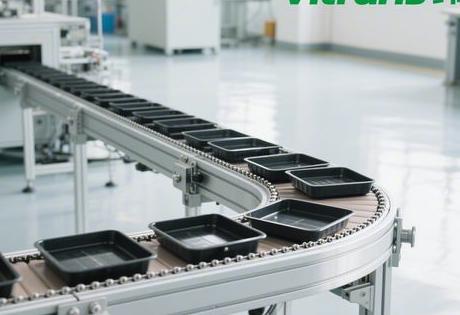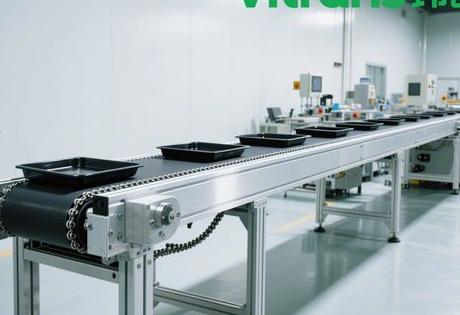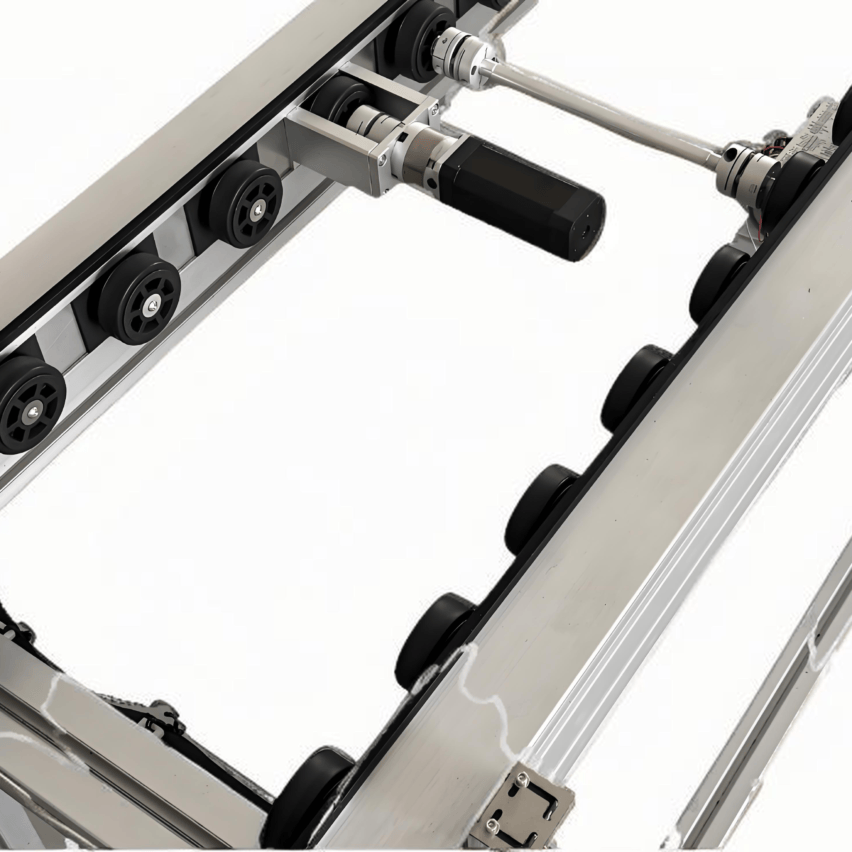Double Speed Chain输送线is becoming an invisible pillar of modern manufacturing, which operates through a synergy of upper and lower levels - theThe upper level carries the production process and the lower level is responsible for the return of empty load boards.--To achieve a double breakthrough in space utilisation and production efficiency in the electronics, automotive, food and other industries. Its core value lies in reconfiguring the traditional linear production process into a three-dimensional circulation system, providing new possibilities for high-density plant and automation integration.

One.Underlying principles: speed-up mechanism and circular logic
-
The mathematical miracle of the multiplier chain
The speed-increasing effect of the multiplier chain comes from the precise geometric design. As the chain advances at speed v₀, the rollers carrying the pallets, whose diameter (D) is greater than the diameter of the rollers (d), drive the pallets at an additional linear speed, resulting in an output speed ofv = v₀ × (1 + D/d). Taking the common 2.5 times the speed chain as an example, the roller and roller diameter ratio needs to reach 1.5:1, so as to realise the efficiency leap through the physical leverage effect. -
Closed-loop system with two-tier synergy
- upper production layer: The workpiece is carried by the workpiece plate and flows according to the process rhythm, and stops precisely at each station through the blocker to complete the assembly or inspection.
- lower return layer: The empty load board is transferred vertically to the lower level by means of a transfer machine (with jacking cylinders and guide rails) and returned to the starting point at base speed.
- control centreThe PLC programme regulates the lifting and lowering of the transfer machine and the starting and stopping of the chain, forming an automatic closed loop of "production-return".
Two.Structural Anatomy: Engineering Intelligence for Modular Design
core component
- loaderVertical Transfer Hub: The power section contains a motor and chain, and the jacking section relies on cylinders and counterweights to balance the load.
- accumulation system: Blocking cylinders with photoelectric sensors enable "pause in motion", allowing specific stations to work independently without interrupting the entire line.
- driver moduleHollow shaft motor is directly connected to the sprocket, and double rows of chain teeth are clamped on both sides of the roller to ensure stable torque transmission.
Trade-offs in material selection
For light load scenarios (e.g. electronic assembly), engineering plastic rollers are used to reduce noise and weight; for heavy load scenarios (e.g. engine assembly), carbon steel chains are used to withstand extreme loads of 4000kg. For the food and pharmaceutical industries, all stainless steel is used to meet corrosion and hygiene requirements.
Three.Industry Adaptation: Universal from 3C Electronics to Heavy Manufacturing
- High-precision electronic assembly
In the 600-metre-long production line of service robots, theModel 08B speed chain with ±0.5mm positioning accuracy.It co-ordinates 10 stages of process such as head, arm, and whole machine assembly, and has no jerky deflection under 90kg load. - Heavy Duty Challenges in Automotive Manufacturing
The gearbox assembly line utilises a double layer structure to separate the main line from the return flow of empty fixtures, solving the congestion of the site caused by heavy workpieces (500kg or more). Extra tensioning wheelsets are added to the lower chain to counteract inertial impacts. - Special optimisation for food medicine
The bakery is resistant to high steam temperatures through a combination of anti-stick coated conveyor belts and stainless steel frames, and the pharmaceutical plant is protected from dust ingress by the addition of a sterile hood to the jacking mechanism.
Four.Technological advantages: generational upgrades beyond single-tier systems
Space compression and efficiency leap
Dongguan, an electronics factory case shows that the replacement of single-layer wire after theSite occupancy reduced by 40%, daily capacity increased by 22%-Originates from the fact that no additional channels are required for the return flow of empty panels, and that the production layer can be produced up to three times faster than the lower layer.
Underpinning support for flexible production
- Quickly adjust the length of the wire body by adding or subtracting modules to adapt to product iterations;
- Standardised interfaces (e.g. pneumatic quick connects, electrical slots) are reserved to support plug-and-play use of robotic arms and vision quality inspectors.
Stability in extreme environments
High-temperature resistant chain (150℃) guarantees continuous operation of automotive painting drying line; sealed bearing design withstands -30℃ low temperature in freezing workshop, and the failure rate is lower than that of traditional drum line.
Five.The versatility myth: the balance between customisation and standardisation
Although modular design offers some flexibility, theIndustry demand for deep customisation is challenging the concept of "general purpose equipment".::

- Compatibility traps: Chain pitches of different manufacturers (e.g. 25.4mm vs. 38.1mm) result in spare parts not being interchangeable;
- load differentiation: 3C industry light-duty wire (200kg) is not compatible with heavy-duty automotive components, and forced modifications can cause tensioning failures.
personal viewpoint: The future breakthrough lies in the establishment of "Standardised base modules, pluggable functional components" ecology - a Lego-like design that reduces cross-vendor adaptation costs by unifying interface specifications.
Six.Design implementation: key decision points
- Multiplier Ratio Selection
2.5 times speed chain balances cost and efficiency, suitable for most assembly scenarios; 3 times speed chain is used for high-speed production lines with a beat <30s, but it needs to be equipped with high-precision guide rail to prevent swing. - Tensioning mechanism optimisation
Conventional centre tensioning can lead to uneven tensioning on both sides.Split tensioning programme(Independent left and right adjustments) Enhances chain life 30%. - Positioning design for jacking
Pneumatic cylinder + linear guide combination to ensure smooth jacking, positioning pins and tooling plate hole tolerance needs to be ≤ 0.1mm, to avoid the accumulation of return deviation.
Seven.Maintenance innovation: predictive maintenance modelling
Beyond the Limits of Traditional Periodic Maintenance
Real-time monitoring of a sensor network in a factory in Wuxi:
- Chain elongation (laser distance measurement) warns of excessive wear;
- Roller vibration spectrum analysis to predict bearing failure;
Reduced breakdown downtime by 60%.
Lubrication Revolution
Food-grade synthetic grease lubrication system replaces manual oiling, with closed-loop pipework dosing, eliminating the risk of contamination and reducing usage by 75%.
Self-questioning: addressing core concerns
Q: Can a double-deck doubler chain directly replace an existing single-deck line?
A: It is necessary to evaluate the matching of space structure and load. If the height of the plant is less than 4 metres or the return level needs to pass under the equipment, it is necessary to re-plan the layout; heavy workpieces need to check the load margin of the lower chain.
Q: Why is the cost of customised wire for automotive factories higher than for electronics factories?
A: The difference comes from three sources: carbon steel chain costs three times as much as engineering plastics, the need for explosion-proof motors (paint shop), and the reinforcement module added to the impact-resistant design.
Currently, the technological evolution of the double-layer multiplier chain is pointing towards theSmart & Green: A Suzhou lab's magnetic levitation multiplier chain eliminates physical contact and reduces energy consumption by 451 TP3T; and recycled nylon rollers have a carbon footprint 621 TP3T lower than metal products - breakthroughs that herald the sustainable DNA of next-generation conveyor systems.













